Related Research Articles
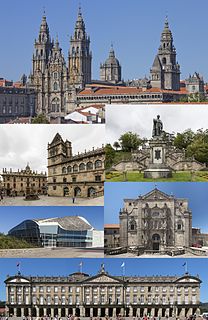
Santiago de Compostela is the capital of the autonomous community of Galicia, in northwestern Spain. The city has its origin in the shrine of Saint James the Great, now the Cathedral of Santiago de Compostela, as the destination of the Way of St. James, a leading Catholic pilgrimage route since the 9th century. In 1985, the city's Old Town was designated a UNESCO World Heritage Site.

Astorga is a municipality and city of Spain located in the central area of the province of León, in the autonomous community of Castilla y León, 43 kilometres (27 mi) southwest of the provincial capital. It is located in the transit between the Páramo Leonés and the mountains of León and acts as the backbone of the shires of Maragatería, La Cepeda and the Ribera del Órbigo. The city is the head of one of the most extensive and oldest dioceses of Spain, whose jurisdiction covers half of the province of León and part of Ourense and Zamora. It is also head of the judicial party number 5 of the province of León.
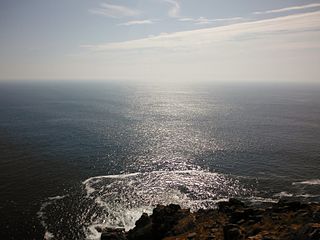
Cape Finisterre is a rock-bound peninsula on the west coast of Galicia, Spain.

James the Great, also known as James, son of Zebedee or as Saint James the Greater, was one of the Twelve Apostles of Jesus according to the New Testament. Saint James is the patron saint of Spain and, according to tradition, his remains are held in Santiago de Compostela in Galicia.

Ourense is a city and capital of the homonymous province located in the autonomous community of Galicia, northwestern Spain. It is on the Portuguese Way path of the Way of St James, and is crossed by the Miño, Barbaña, Loña and Barbañica rivers. It is also known as A cidade das Burgas due to its hot springs, being one of the European cities with the greatest thermal heritage.
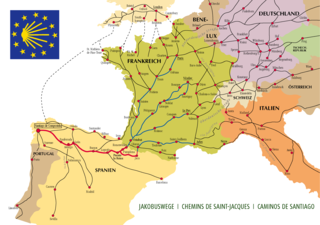
The Camino de Santiago, known in English as the Way of St. James, is a network of pilgrims' ways or pilgrimages leading to the shrine of the apostle Saint James the Great in the cathedral of Santiago de Compostela in Galicia in northwestern Spain, where tradition has it that the remains of the saints are buried there. Many follow its routes as a form of spiritual path or retreat for their spiritual growth. It is also popular with hiking and cycling enthusiasts and organized tour groups.
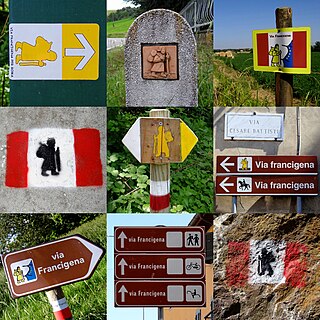
The Via Francigena is the common name of an ancient road and pilgrim route running from France to Rome and Apulia, where there were the ports of embarkation for the Holy Land, though it is usually considered to have its starting point on the other side of the English Channel, in the cathedral city of Canterbury. As such, the route passes through England, France, Switzerland and Italy. The route was known in Italy as the "Via Francigena" or the "Via Romea Francigena". In medieval times it was an important road and pilgrimage route for those wishing to visit the Holy See and the tombs of the apostles Peter and Paul.

Puente la Reina is a town and municipality located in the autonomous community of Navarre, in northern Spain.
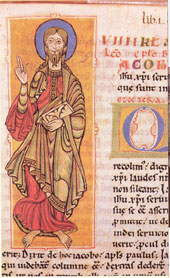
The Codex Calixtinus is the main witness for the 12th-century Liber Sancti Jacobi, or the Book of Saint James. It is a pseudepigraph attributed to Pope Callixtus II; its principal author or compilator is referred to as "Pseudo-Callixtus", often identified with French scholar Aymeric Picaud. Its most likely date of compilation is the period of 1138–1145.

The Camino de Santiago, also known as the Way of St. James, extends from different countries of Europe, and even North Africa, on its way to Santiago de Compostela and Finisterre. The local authorities try to restore many of the ancient routes, even those used in a limited period, in the interest of tourism.
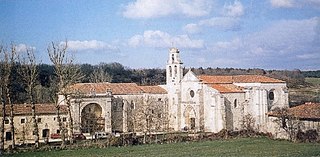
The old monastery of San Juan de Ortega is a Romanesque monument in Barrios de Colina, in the province of Burgos, Spain.

The French Way is the most popular of the routes of the Way of St. James, the ancient pilgrimage route to Santiago de Compostela in Galicia, Spain. It runs from Saint-Jean-Pied-de-Port on the French side of the Pyrenees to Roncesvalles on the Spanish side and then another 780 km on to Santiago de Compostela through the major cities of Pamplona, Logroño, Burgos and León. A typical walk on the Camino francés takes at least four weeks, allowing for one or two rest days on the way. Some travel the Camino on bicycle or on horseback.
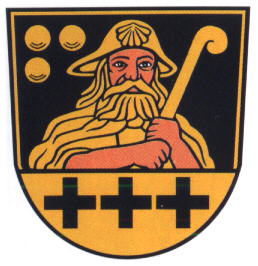
A pilgrim's hat, cockel hat or traveller's hat is a wide brim hat used to keep off the sun.
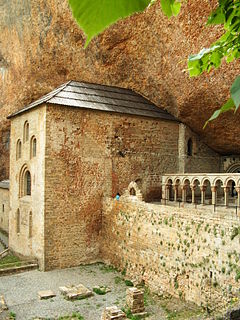
Christianity has a strong tradition of pilgrimages, both to sites relevant to the New Testament narrative and to sites associated with later saints or miracles.

The Way is a 2010 American-Spanish drama film directed, produced and written by Emilio Estevez and starring Martin Sheen, Deborah Kara Unger, James Nesbitt, Yorick van Wageningen, and Renée Estevez.

Pilgrim Paths Ireland (PPI) is a non-denominational representative body for Ireland's medieval pilgrim paths. PPI was founded in 2013 to oversee the development and promotion of Ireland's medieval pilgrimage paths, and consists of 12 community groups supporting specific paths. PPI holds an annual National Pilgrimage Paths Week during Easter, and issues a National Pilgrimage Passport to finishers of the 5 main trails: Cnoc na dTobar, Cosán na Naomh, St. Finbarr's Pilgrim Path, St. Kevin’s Way, and Tochar Phádraig.
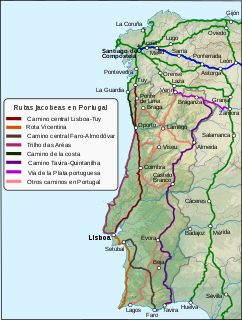
The Portuguese Way is the name of the Camino de Santiago pilgrimage routes starting in Portugal. It begins at Porto or Lisbon. From Porto, along the Douro River, pilgrims travel north crossing the five main rivers—the Ave, Cávado, Neiva, Lima and Minho—before entering Spain and passing through Padrón on the way to Santiago de Compostela.
The English Way is one of the paths of the Camino de Santiago. It begins in the Galician port cities of Ferrol (118 km) or A Coruña (75 km) and runs south to Santiago de Compostela.
The Primitive Way is one of the paths of the Camino de Santiago. It begins in the old Asturian capital of Oviedo and runs west to Lugo and then south to Santiago de Compostela joining the more popular French Way in Melide for the last two hiking days. According to the Confraternity of St James, the Camino Primitivo is approximately 370 km in length.

St Michael’s Way is a waymarked long-distance footpath in Cornwall. It runs for 12.5 miles (20 km) from Lelant on Cornwall’s north coast to St Michael’s Mount on the south coast.
References
- ↑ Guiberteau, Olivier (12 April 2019). "The Camino de Santiago's Ancient Secret". BBC . Retrieved 15 May 2019.
- ↑ Bennett, Annie. "How to do the Camino de Santiago walk". The Daily Telegraph . Retrieved 15 May 2019.
- ↑ Martin, Craig (12 Aug 2013). "Walking the Camino de Santiago: A Beginner's Guide". Outside Magazine . Retrieved 15 May 2019.
